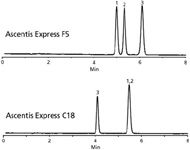The Separation of Closely Related Compounds Using Ascentis Express F5
The separation of closely related compounds is of interest to many disciplines including natural products, flavors and fragrances, and pharmaceuticals.
David S. Bell and Carmen T. Santasania, Supelco/Sigma-Aldrich
The separation of closely related compounds is of interest to many disciplines including natural products, flavors and fragrances, and pharmaceuticals. The Ascentis® Express F5 HPLC columns have a unique mix of shape selectivity, ionic character, and hydrophobic retention to provide the selectivity needed for the separation of closely related compounds.
Ascentis Express is a high-speed, HPLC column based on Fused-Core® particle technology. The F5 bonded phase exhibits strong dipole potential (polar interaction) from the carbon-fluorine bonds, pi-pi interaction potential, and the ability to interact via charge-transfer interactions due to the electronegativity of the fluorine atoms. The rigidity of the F5 phase is believed to provide enhanced shape selectivity of analytes differing in size and spatial attributes. Chromatographers are often faced with the challenge of separating compounds that are very similar in their solubility. Separation on nonpolar phases such as C18 is driven by differential partitioning of analytes, therefore, the alkyl phases are often ineffective in meeting this challenge. Hydrocortisone and prednisolone (see Figure 1) differ by a single double bond. Their solubility is very similar; however, their shapes differ significantly. Figure 2 shows a comparison of their separation, along with prednisone internal standard (IS), using both a C18 and an F5 stationary phase. The F5 phase is shown to provide the separation of these closely related compounds.

Figure 1: Structures of Hydrocortisone and Prednisolone.
Conclusions
F5 phase exhibits increased ionic and polar interactions relative to common alkyl phases. The rigidity of the F5 phase also provides increased shape selectivity over commonly used alkyl phases. These alternative mechanisms of retention often provide selectivity not readily achieved on the more traditional phases. Retention and selectivity of highly polar and ionic species as well as separation of closely related neutral compounds have been used to demonstrate the power of the F5 phase. The combination of the selectivity provided by the F5 phase and the efficiency of Fused-Core particles provides even greater resolving power.

Figure 2: Comparison of C18 and F5 for the separation of closely related steroids. Column(s): Ascentis Express F5 (53590-U) and Ascentis Express C18 (53827-U), 10 cm à 4.6 mm, I.D., 2.7 µm particle size, mobile phase A: water, mobile phase B: methanol, mobile phase ratio: A:B 50:50, v/v, flow rate: 0.8 mL/min., temp.: 35 °C, det.: UV at 240 nm, Peaks: 1. Hydrocortisone, 2. Prednisolone, 3. Prednisone (IS).
Trademarks: Ascentis — Sigma-Aldrich Biotechnology LP; Fused-Core — Advanced Materials Technology, Inc.
Supelco/Sigma-Aldrich
595 North Harrison Road, Bellefonte, PA 16823
tel. (800) 359-3041, fax (800) 359-3044
Email: techservice@sial.com, Website: www.sigma-aldrich.com
















The Benefits of Custom Bonded Silica
April 1st 2025Not all chromatography resins are created equal. Off-the-shelf chromatography resins might not always meet the rigorous purification requirements of biopharmaceutical manufacturing. Custom bonded silica from Grace can address a wide range of separation challenges, leading to real performance improvements. Discover more about the latest innovations in chromatography silica from Grace, including VYDAC® and DAVISIL®.
5 Things to Consider When Selecting a Chromatography Silica
April 1st 2025Particularly in the pharmaceutical industry, drug purity isn’t just a goal – it’s essential for achieving safety, stability and efficacy. However, purification is easier said than done, especially with challenging molecules like DNA and RNA “oligonucleotides,” due in large part to their diversity and the range of impurities that can be generated during production. Enter DAVISIL® chromatographic silica, with a wide range of pore diameters and particle sizes to meet your specific application, performance and sustainability requirements. Before you choose the chromatography resin for your next purification application, take a look at these 5 considerations.
Automating Protein Purification: Efficiency, Yield, and Reproducibility
March 27th 2025Recent advancements in automated protein purification stress the importance of efficiency, scalability, and yield consistency. This eBook compares different purification platforms, highlighting their impact on downstream applications and demonstrating how automation enhances throughput and process control.
MilliporeSigma: Ultrapure Water for Sensitive LC-MS Analysis of Pesticides
March 25th 2025The aim of the study was to illustrate the efficiency of Milli-Q® water purification systems in eliminating pesticides from tap water, thereby producing and delivering reliable and consistent-quality ultrapure water suitable for pesticides analysis
The Benefits of Custom Bonded Silica
April 1st 2025Not all chromatography resins are created equal. Off-the-shelf chromatography resins might not always meet the rigorous purification requirements of biopharmaceutical manufacturing. Custom bonded silica from Grace can address a wide range of separation challenges, leading to real performance improvements. Discover more about the latest innovations in chromatography silica from Grace, including VYDAC® and DAVISIL®.
5 Things to Consider When Selecting a Chromatography Silica
April 1st 2025Particularly in the pharmaceutical industry, drug purity isn’t just a goal – it’s essential for achieving safety, stability and efficacy. However, purification is easier said than done, especially with challenging molecules like DNA and RNA “oligonucleotides,” due in large part to their diversity and the range of impurities that can be generated during production. Enter DAVISIL® chromatographic silica, with a wide range of pore diameters and particle sizes to meet your specific application, performance and sustainability requirements. Before you choose the chromatography resin for your next purification application, take a look at these 5 considerations.
Automating Protein Purification: Efficiency, Yield, and Reproducibility
March 27th 2025Recent advancements in automated protein purification stress the importance of efficiency, scalability, and yield consistency. This eBook compares different purification platforms, highlighting their impact on downstream applications and demonstrating how automation enhances throughput and process control.
MilliporeSigma: Ultrapure Water for Sensitive LC-MS Analysis of Pesticides
March 25th 2025The aim of the study was to illustrate the efficiency of Milli-Q® water purification systems in eliminating pesticides from tap water, thereby producing and delivering reliable and consistent-quality ultrapure water suitable for pesticides analysis
